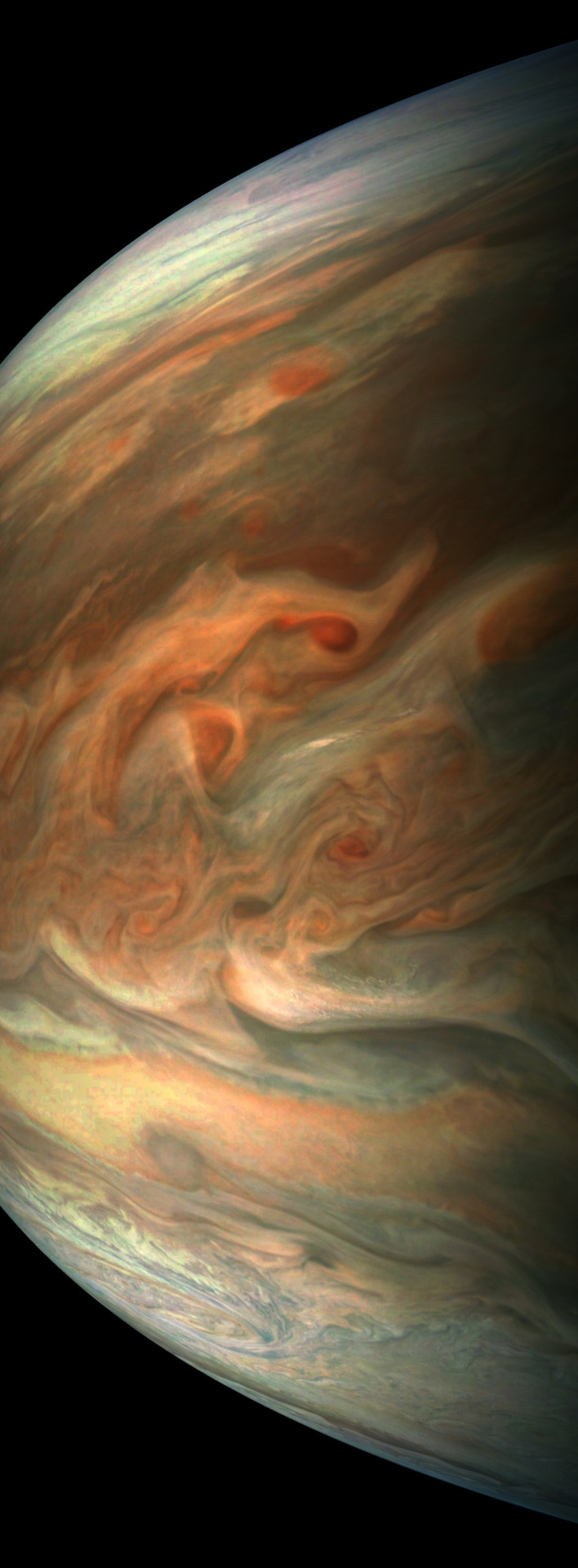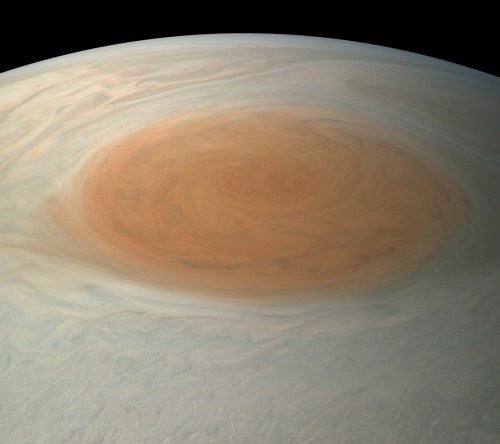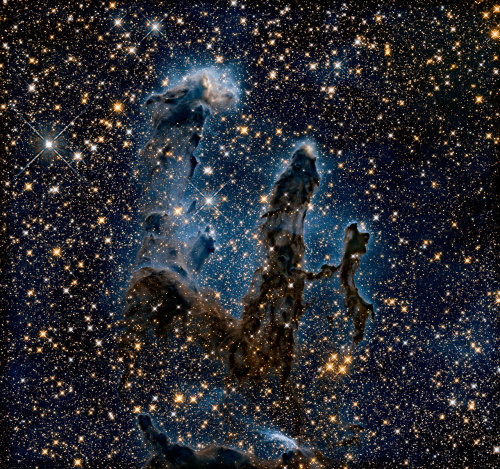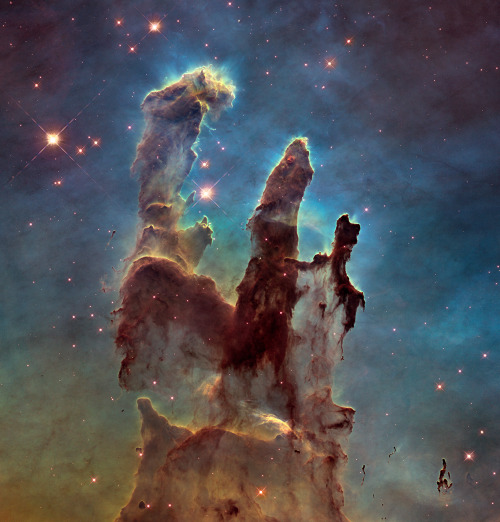Solar System: Things To Know This Week
Solar System: Things to Know This Week
Our solar system is huge, let us break it down for you. Here are a few things to know this week:
1. Up at Jupiter, It’s Down to Business

Ever since our Juno mission entered Jupiter's orbit on July 4, engineers and scientists have been busy getting their newly arrived spacecraft ready for operations. Juno's science instruments had been turned off in the days leading up to Jupiter orbit insertion. As planned, the spacecraft powered up five instruments on July 6, and the remaining instruments should follow before the end of the month. The Juno team has also scheduled a short trajectory correction maneuver on July 13 to refine the orbit.
2. The Shadows Know

Scientists with our Dawn mission have identified permanently shadowed regions on the dwarf planet Ceres. Most of these areas likely have been cold enough to trap water ice for a billion years, suggesting that ice deposits could exist there now (as they do on the planet Mercury). Dawn is looking into it.
3. Frosts of Summer

Some dusty parts of Mars get as cold at night year-round as the planet's poles do in winter, even in regions near the equator in summer, according to new findings based on Mars Reconnaissance Orbiter observations. The culprit may be Mars' ever-present dust.
4. Can You Hear Me Now?

The OSIRIS-REx spacecraft is designed to sample an asteroid and return that sample to Earth. After launch in Sept., the mission's success will depend greatly on its communications systems with Earth to relay everything from its health and status to scientific findings from the asteroid Bennu. That's why engineers from our Deep Space Network recently spent a couple of weeks performing detailed tests of the various communications systems aboard OSIRIS-REx.
5. Cometary Close-ups

The Rosetta spacecraft has taken thousands of photographs of Comet 67/P. The European Space Agency (ESA) is now regularly releasing the highest-resolution images. The word "stunning" is used a lot when referring to pictures from space—and these ones truly are. See the latest HERE.
Want to learn more? Read our full list of the 10 things to know this week about the solar system HERE.
Make sure to follow us on Tumblr for your regular dose of space: http://nasa.tumblr.com
More Posts from Nasa and Others
Things That Go Bump in the Gamma Rays
Some people watch scary movies because they like being startled. A bad guy jumps out from around a corner! A monster emerges from the shadows! Scientists experience surprises all the time, but they’re usually more excited than scared. Sometimes theories foreshadow new findings — like when there’s a dramatic swell in the movie soundtrack — but often, discoveries are truly unexpected.

Scientists working with the Fermi Gamma-Ray Space Telescope have been jumping to study mysterious bumps in the gamma rays for a decade now. Gamma rays are the highest-energy form of light. Invisible to human eyes, they’re created by some of the most powerful and unusual events and objects in the universe. In celebration of Halloween, here are a few creepy gamma-ray findings from Fermi’s catalog.

Stellar Graveyards
If you were to walk through a cemetery at night, you’d expect to trip over headstones or grave markers. Maybe you’d worry about running into a ghost. If you could explore the stellar gravesite created when a star explodes as a supernova, you’d find a cloud of debris expanding into interstellar space. Some of the chemical elements in that debris, like gold and platinum, go on to create new stars and planets! Fermi found that supernova remnants IC 443 and W44 also accelerate mysterious cosmic rays, high-energy particles moving at nearly the speed of light. As the shockwave of the supernova expands, particles escape its magnetic field and interact with non-cosmic-ray particles to produce gamma rays.

Ghost Particles
But the sources of cosmic rays aren’t the only particle mysteries Fermi studies. Just this July, Fermi teamed up with the IceCube Neutrino Observatory in Antarctica to discover the first source of neutrinos outside our galactic neighborhood. Neutrinos are particles that weigh almost nothing and rarely interact with anything. Around a trillion of them pass through you every second, ghost-like, without you noticing and then continue on their way. (But don’t worry, like a friendly ghost, they don’t harm you!) Fermi traced the neutrino IceCube detected back to a supermassive black hole in a distant galaxy. By the time it reached Earth, it had traveled for 3.7 billion years at almost the speed of light!

Black Widow Pulsars
Black widows and redbacks are species of spiders with a reputation for devouring their partners. Astronomers have discovered two types of star systems that behave in a similar way. Sometimes when a star explodes as a supernova, it collapses back into a rapidly spinning, incredibly dense star called a pulsar. If there’s a lighter star nearby, it can get stuck in a close orbit with the pulsar, which blasts it with gamma rays, magnetic fields and intense winds of energetic particles. All these combine to blow clouds of material off the low-mass star. Eventually, the pulsar can eat away at its companion entirely.

Dark Matter
What’s scarier than a good unsolved mystery? Dark matter is a little-understood substance that makes up most of the matter in the universe. The stuff that we can see — stars, people, haunted houses, candy — is made up of normal matter. But our surveys of the cosmos tell us there’s not enough normal matter to keep things working the way they do. There must be another type of matter out there holding everything together. One of Fermi’s jobs is to help scientists narrow down the search for dark matter. Last year, researchers noticed that most of the gamma rays coming from the Andromeda galaxy are confined to its center instead of being spread throughout. One possible explanation is that accumulated dark matter at the center of the galaxy is emitting gamma rays!

Fermi has helped us learn a lot about the gamma-ray universe over the last 10 years. Learn more about its accomplishments and the other mysteries it’s working to solve. What other surprises are waiting out among the stars?
Make sure to follow us on Tumblr for your regular dose of space: http://nasa.tumblr.com.
@mothdog: What is something everyone needs to know about the International Space Station and science in space?
Science, Technology, Engineering and Math: STEM
Today is College Signing Day and we’re working with the White House to celebrate all graduating seniors and inspire more young people to Reach Higher and enroll in higher education.

Additionally, choosing a degree within a STEM (Science, Math, Engineering and Technology) field enables the United States to remain the global economic and technological leader. We feel that it’s our duty to help inspire the next generation of scientists, technologists, engineers and astronauts.

It’s important that each and every student feels empowered and equipped with the knowledge to solve tough problems, evaluate evidence and analyze information. These are all skills students can learn through studying a subjects in STEM.
College is one of the stepping stones to many careers, including becoming an astronaut! Here are a few of our astronauts on their college graduation day, along with their astronaut portrait.
Astronaut Victor Glover

Undergraduate: California Polytechnic State University Graduate: Air University and Naval Postgraduate School Astronaut Class: 2013
Astronaut Reid Wiseman

Undergraduate: Rensselaer Polytechnic Institute Graduate: Johns hopkins University Astronaut Class: 2009
Astronaut Thomas Marshburn

Undergraduate: Davidson College Graduate: University of Virginia, Wake Forest University and University of Texas medical Branch Astronaut Class: 2004
Astronaut Karen Nyberg

Undergraduate: University of North Dakota Graduate: University of Texas at Austin Astronaut Class: 2000
Astronaut Bob Behnken

Undergraduate: Washington University Graduate: California Institute of Technology Astronaut Class: 2000
Astronaut Peggy Whitson

Undergraduate: Iowa Wesleyan College Graduate: Rice University Astronaut Class: 1996
Astronaut Joseph Acaba

Undergraduate: University of California Graduate: University of Arizona Astronaut Class: 2004
Astronaut Rex Walheim

Undergraduate: University of California, Berkeley Graduate: University of Houston Astronaut Class: 1996
Whether you want to be an astronaut, an engineer or the administrator of NASA, a college education opens a universe of possibilities:
Administrator Charles Bolden

Here, Administrator Bolden wears the jersey of Keenan Reynolds, a scholar athlete who graduates from the Naval Academy this year. His jersey is on its way to the college football hall of fame. Bolden holds a drawing of himself as a midshipman in the Navy.
Deputy Administrator Dava Newman

Deputy Administrator Dava Newman sports her college shirt, along with Lisa Guerra, Technical Assistant to the Associate Administrator. Both women studied aerospace engineering at Notre Dame.
Make sure to follow us on Tumblr for your regular dose of space: http://nasa.tumblr.com
Solar System: Things to Know This Week
Our Juno mission has been exploring Jupiter since July 2016 with a special passenger on board: JunoCam, an instrument designed to take spectacular close-up color images of the largest planet in our solar system. From the raw images, citizen scientists have processed a range of beautiful photographs that highlight Jupiter's features, even turning them into works of art. Below, 10 stunning images JunoCam has given us over the past year.
1. Jovian tempest.

This color-enhanced image of a massive, raging storm in Jupiter's northern hemisphere was captured by our Juno spacecraft during its ninth close flyby on Oct. 24, 2017. The storm is rotating counter-clockwise with a wide range of cloud altitudes, and the darker clouds are expected to be deeper in the atmosphere than the brightest clouds.
2. A southern stunner.

Jupiter's southern hemisphere shows off in beautiful detail in this image taken on Oct. 24, 2017. The color-enhanced view captures one of the white ovals in the "String of Pearls," one of eight massive rotating storms at 40 degrees south latitude on the gas giant planet.
3. Dreaming in color.

Artist Mik Petter created this unique digital piece using data from the JunoCam. The art form, known as fractals, uses mathematical formulas to create an infinite variety of form, detail, color and light. The original JunoCam image was taken on July 10, 2017.
4. Jovian moon shadow.

Jupiter's moon Amalthea casts a shadow on the gas giant planet in this image taken on Sept. 1, 2017. The elongated shape of the shadow is a result of both the location of the moon with relation to Jupiter in this image as well as the irregular shape of the moon itself.
5. 95 minutes over Jupiter.

Once every 53 days, Juno swings close to Jupiter, speeding over its clouds. In about two hours, the spacecraft travels from a perch over Jupiter's north pole through its closest approach (perijove), then passes over the south pole on its way back out. This sequence shows 11 color-enhanced images from Perijove 8 (Sept. 1, 2017) with the south pole on the left (11th image in the sequence) and the north pole on the right (first image in the sequence).
6. Soaring high.

This striking image of Jupiter was taken on Sept. 1, 2017 as Juno performed its eighth flyby. The spacecraft was 4,707 miles (7,576 kilometers) from the tops of the clouds of the planet at a latitude of about -17.4 degrees. Noteworthy: "Whale's Tail" and "Dan's Spot."
7. In true color.

This true-color image offers a natural color rendition of what the Great Red Spot and surrounding areas would look like to human eyes from Juno's position. The image was taken on July 10, 2017 as the Juno spacecraft performed its seventh close flyby of Jupiter.
8. The 'face' of Jupiter.

JunoCam images aren't just for art and science—sometimes they're created for a good chuckle. This image, processed by citizen scientist Jason Major, is titled "Jovey McJupiterface." By rotating the image 180 degrees and orienting it from south up, two white oval storms turn into eyeballs, and the "face" of Jupiter is revealed. The original image was taken by the Juno spacecraft on May 19, 2017.
9. Bands of clouds.

This enhanced-color image of Jupiter's bands of light and dark clouds was created by citizen scientists Gerald Eichstädt and Seán Doran. Three of the white oval storms known as the "String of Pearls" are visible near the top of the image. Each of the alternating light and dark atmospheric bands in this image is wider than Earth, and each rages around Jupiter at hundreds of miles (kilometers) per hour. The lighter areas are regions where gas is rising, and the darker bands are regions where gas is sinking. Juno captured the image on May 19, 2017.
10. The edge.

This enhanced-color image of a mysterious dark spot on Jupiter seems to reveal a Jovian "galaxy" of swirling storms. Juno captured this image on Feb. 2, 2017 and citizen scientist Roman Tkachenko enhanced the color to bring out the rich detail in the storm and surrounding clouds. Just south of the dark storm is a bright, oval-shaped storm with high, bright, white clouds, reminiscent of a swirling galaxy. As a final touch, he rotated the image 90 degrees, turning the picture into a work of art.
To learn more about the Juno mission at Jupiter, visit: www.nasa.gov/juno.
Follow the Juno mission on Facebook, Instagram and Twitter.
Make sure to follow us on Tumblr for your regular dose of space: http://nasa.tumblr.com.
Solar System: Things to Know This Week
The solar system is vast, and exploring it requires not one expedition, but many. From the sun to the Earth to the depths of space beyond Pluto, an entire fleet of spacecraft is pushing back the frontiers of knowledge. Scientists and engineers around the world work together on dozens of missions, and the results of their work unfold on a daily basis. During any given week, astronauts and robotic spacecraft return thousands of pictures and other data from Earth orbit and from half a dozen other worlds.
The result? It’s nothing short of a visual and intellectual feast. For example, all of the following images were obtained over the course of one week during January this year.
The same missions that took these pictures are still at work – they may be photographing Saturn or transmitting a report from Mars as you read this.
1. The Sun

From its clear vantage point in Earth orbit, our Solar Dynamics Observatory (SDO) observes our nearby star almost continuously. This image shows activity on the sun’s surface on Jan. 18. You can also get similar pictures from SDO daily!
2. The Earth from Afar

The DSCOVR satellite orbits the Earth at a distance of nearly a million miles (1.5 million kilometers). It’s Earth Polychromatic Imaging Camera (EPIC) keeps a steady watch on the home planet. This is how the world turned on Jan. 20. Get the latest daily images from EPIC HERE.
3. Mars from Above

The team that manages the Mars Reconnaissance Orbiter (MRO) recently celebrated a decade of observing the Red Planet. MRO took this detailed look at dunes and rocky buttes in Danielson Crater on Jan. 24. It was 3:06 p.m., local Mars time. On the right stide of the image, dust devils have left tracks in the sand.
4. Comet 67/P

The European Space Agency’s Rosetta probe caught this look at the surface of Comet 67/P from a distance of just 46 miles (75 kilometers) on Jan. 23.
5. Saturn

On the same day (Jan. 23), our Cassini spacecraft continued its odyssey of nearly two decades in space, bringing us this look at the sixth planet. See the latest images from Cassini HERE.
Want to learn more? Read our full list of the 10 things to know this week about the solar system HERE.
Make sure to follow us on Tumblr for your regular dose of space: http://nasa.tumblr.com


Sometimes... there’s more than meets the eye. 👀 You’re looking at two very different takes on an iconic image.
Human eyes can see only a small portion of the range of radiation given off by the objects around us. We call this wide array of radiation the electromagnetic spectrum, and the part we can see visible light.
In the first image, researchers revisited one of Hubble Space Telescope’s most popular sights: the Eagle Nebula’s Pillars of Creation. Here, the pillars are seen in infrared light, which pierces through obscuring dust and gas and unveil a more unfamiliar — but just as amazing — view of the pillars. The entire frame is peppered with bright stars and baby stars are revealed being formed within the pillars themselves. The image on the bottom is the pillars in visible light.
Image Credit: NASA, ESA/Hubble and the Hubble Heritage Team
Make sure to follow us on Tumblr for your regular dose of space: http://nasa.tumblr.com.
What was the hardest part in training to go to space?
One of the most challenging parts of space training was learning how to use the space suit. We weigh over 400 pounds in the space suit, and since it is pressurized, each movement of your hands is like working against an exercise ball. Since the suit needs to be quite bulky in order to protect us from the environment of space (vacuum, radiation, micrometeoroids, extreme temperature) while doing a spacewalk, it makes body movements a bit awkward. Dexterity is quite compromised with the bulky gloves as well. Although it is challenging, however, it is likely also the most rewarding, because, well, you are in a SPACE SUIT!!! Hopefully I’ll get to do a spacewalk and look down on the our planet from above on a mission to the International Space Station in a few years.
Join NPR today at 5 p.m. EDT for #NPRSpaceJam with astronauts Serena Auñón, Cady Coleman, Samantha Cristoforetti, plus our chief scientist Ellen Stofan. Submit your questions!

Tomorrow at 5ET I’ll be interviewing three astronauts (read all about them here) live on Periscope and Snapchat (user: nprnews).
What would you like me to ask them? Submit questions here.
Our pale blue dot, planet Earth, is seen in this video captured by NASA astronaut Jack Fischer from his unique vantage point on the International Space Station. From 250 miles above our home planet, this time-lapse imagery takes us over the Pacific Ocean’s moon glint and above the night lights of San Francisco, CA. The thin hue of our atmosphere is visible surrounding our planet with a majestic white layer of clouds sporadically seen underneath.
The International Space Station is currently home to 6 people who are living and working in microgravity. As it orbits our planet at 17,500 miles per hour, the crew onboard is conducting important research that benefits life here on Earth.
Make sure to follow us on Tumblr for your regular dose of space: http://nasa.tumblr.com
Houston, We Have a Launch!
Today, three new crew members will launch to the International Space Station. NASA astronaut Jeff Williams, along with Russian cosmonauts Alexey Ovchinin and Oleg Skripochka, are scheduled to launch from the Baikonur Cosmodrome in Kazakhstan at 5:26 p.m. EDT. The three Expedition 47 crew members will travel in a Soyuz spacecraft, rendezvousing with the space station six hours after launch.

Traveling to the International Space Station is an exciting moment for any astronaut. But what if you we’re launching to orbit AND knew that you were going to break some awesome records while you were up there? This is exactly what’s happening for astronaut Jeff Williams.
This is a significant mission for Williams, as he will become the new American record holder for cumulative days in space (with 534) during his six months on orbit. The current record holder is astronaut Scott Kelly, who just wrapped up his one-year mission on March 1.
On June 4, Williams will take command of the station for Expedition 48. This will mark his third space station expedition…which is yet another record!
Want to Watch the Launch?

You can! Live coverage will begin at 4:30 p.m. EDT on NASA Television, with launch at 5:26 p.m.
Tune in again at 10:30 p.m. to watch as the Soyuz spacecraft docks to the space station’s Poisk module at 11:12 p.m.
Hatch opening coverage will begin at 12:30 a.m., with the crew being greeted around 12:55 a.m.
NASA Television: https://www.nasa.gov/nasatv
Follow Williams on Social!

Astronaut Jeff Williams will be documenting his time on orbit, and you can follow along on Facebook, Instagram and Twitter.
Make sure to follow us on Tumblr for your regular dose of space: http://nasa.tumblr.com
-
 jen2cool liked this · 7 years ago
jen2cool liked this · 7 years ago -
 worldart1 reblogged this · 7 years ago
worldart1 reblogged this · 7 years ago -
 thabolm reblogged this · 8 years ago
thabolm reblogged this · 8 years ago -
 thelettersfromnoone liked this · 8 years ago
thelettersfromnoone liked this · 8 years ago -
 loudman1 reblogged this · 8 years ago
loudman1 reblogged this · 8 years ago -
 livingwithendo reblogged this · 8 years ago
livingwithendo reblogged this · 8 years ago -
 c9eeeeed liked this · 8 years ago
c9eeeeed liked this · 8 years ago -
 grelse reblogged this · 8 years ago
grelse reblogged this · 8 years ago -
 bunjiking-blog liked this · 8 years ago
bunjiking-blog liked this · 8 years ago -
 redlightams-blog liked this · 8 years ago
redlightams-blog liked this · 8 years ago -
 flowersbeauty-16 liked this · 8 years ago
flowersbeauty-16 liked this · 8 years ago -
 evolutionofstudying-blog reblogged this · 8 years ago
evolutionofstudying-blog reblogged this · 8 years ago -
 regly liked this · 8 years ago
regly liked this · 8 years ago -
 arizona-in-my-veins reblogged this · 8 years ago
arizona-in-my-veins reblogged this · 8 years ago -
 zsiltz-blog liked this · 8 years ago
zsiltz-blog liked this · 8 years ago -
 penguintamer reblogged this · 8 years ago
penguintamer reblogged this · 8 years ago -
 evolutionofstudying-blog liked this · 8 years ago
evolutionofstudying-blog liked this · 8 years ago -
 acrylic-grapes-blog1 liked this · 8 years ago
acrylic-grapes-blog1 liked this · 8 years ago -
 poro-oletettu reblogged this · 8 years ago
poro-oletettu reblogged this · 8 years ago -
 c-chanfromda liked this · 8 years ago
c-chanfromda liked this · 8 years ago -
 katsu-not-found reblogged this · 8 years ago
katsu-not-found reblogged this · 8 years ago -
 asitrita liked this · 8 years ago
asitrita liked this · 8 years ago -
 soyuncalimero reblogged this · 8 years ago
soyuncalimero reblogged this · 8 years ago -
 soyuncalimero liked this · 8 years ago
soyuncalimero liked this · 8 years ago -
 jeza-jezaro reblogged this · 8 years ago
jeza-jezaro reblogged this · 8 years ago -
 ffehutchi-blog reblogged this · 8 years ago
ffehutchi-blog reblogged this · 8 years ago -
 alicerobertstext reblogged this · 8 years ago
alicerobertstext reblogged this · 8 years ago -
 itsjustadri1-blog liked this · 8 years ago
itsjustadri1-blog liked this · 8 years ago -
 miomckittykatofthegreatdinosaur liked this · 8 years ago
miomckittykatofthegreatdinosaur liked this · 8 years ago -
 littleplasticspaceship reblogged this · 8 years ago
littleplasticspaceship reblogged this · 8 years ago -
 disappointallize liked this · 8 years ago
disappointallize liked this · 8 years ago -
 rememberalecs reblogged this · 8 years ago
rememberalecs reblogged this · 8 years ago -
 myfaithwillstand liked this · 8 years ago
myfaithwillstand liked this · 8 years ago
Explore the universe and discover our home planet with the official NASA Tumblr account
1K posts